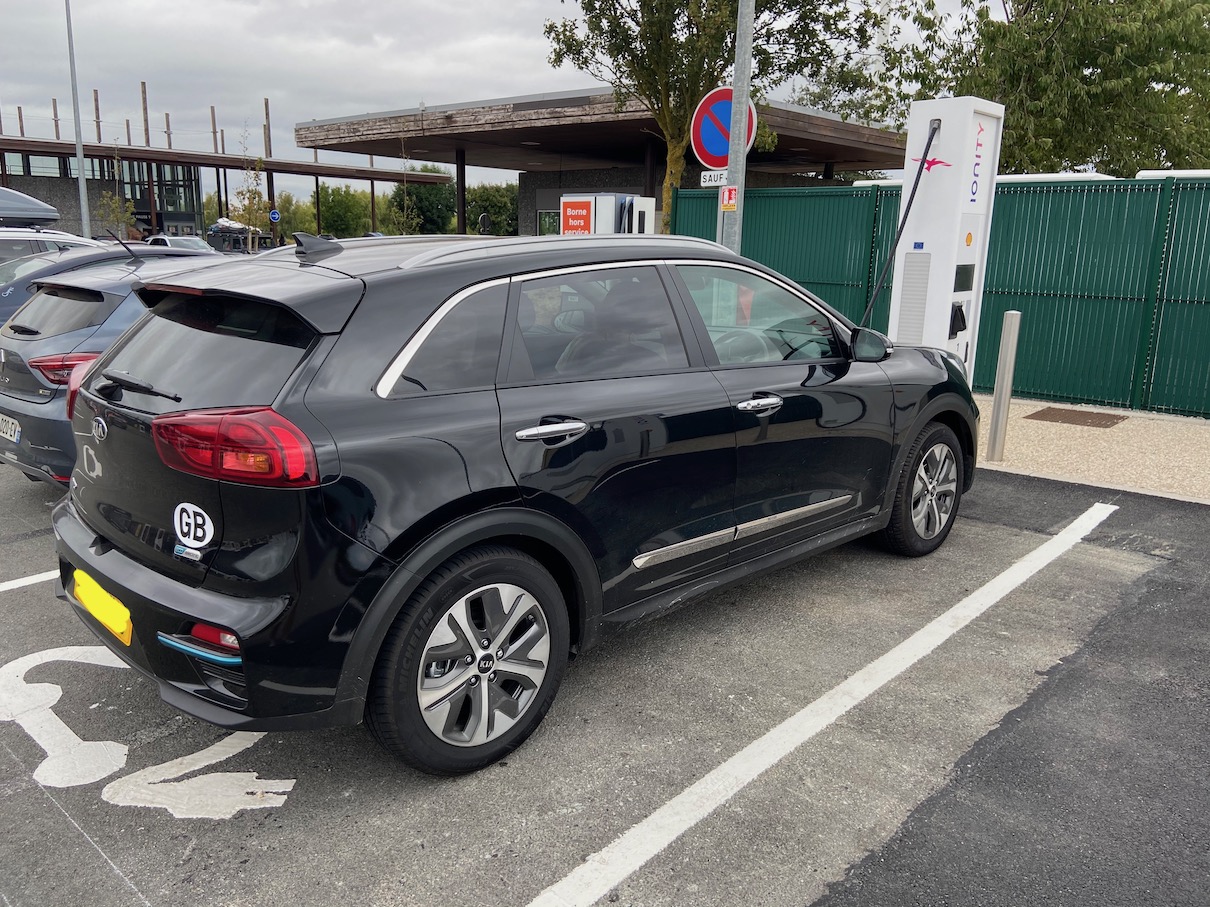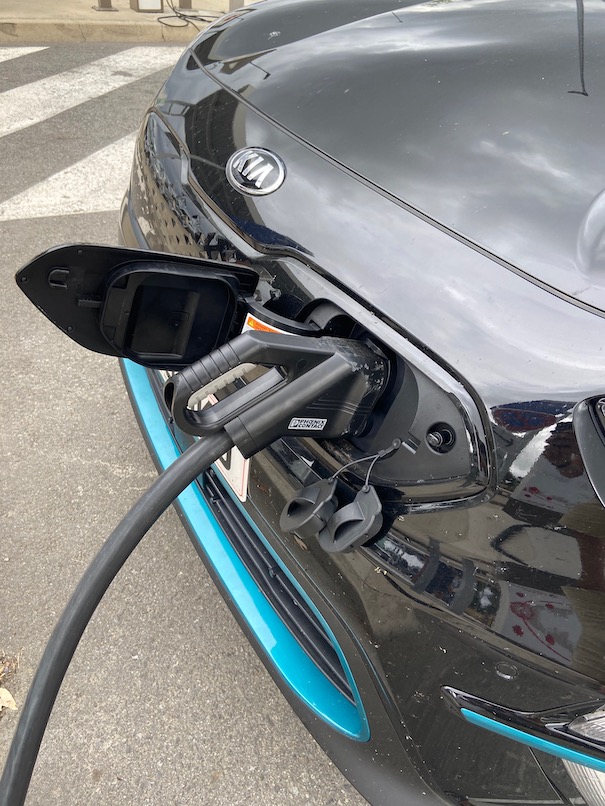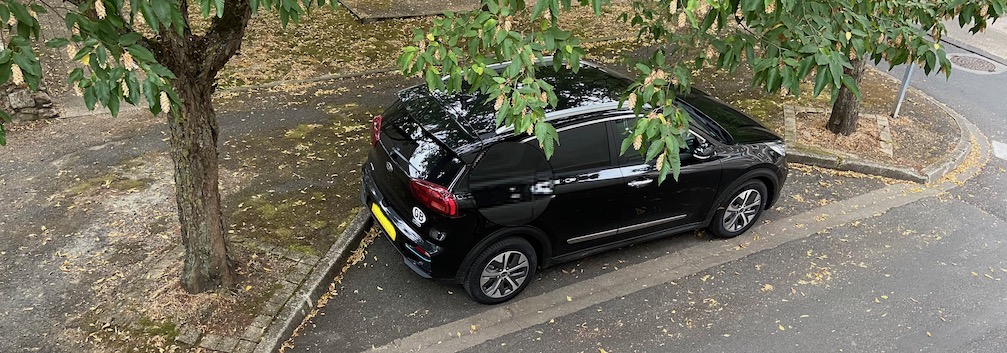Overview
Summary
- Going on a long journey in an EV will add an hour or two to a day’s travel and requires a little bit of advance planning but is far from some sort of foolhardy adventure
- At least two weeks before you go to France, apply for a Chargemap card and an Air Quality Certificate
- You might be interested in a spreadsheet with some data about the journey
Purchase
We decided we wanted an electric car around Easter 2019. I was working quite a way from home and was having to drive just over 100 miles per day. Having researched available models, we settled on the Kia e-Niro; it was comparatively affordable, was a sensible size car for a family and had a practical range (280 miles). The trouble was that it also had a waiting list of over a year. After some deliberation, we put our names down…
We unexpectedly got a phone call “only” ten months later, to say that our car was available if we still wanted it. As a result, we took delivery of a new car one day before the Coronavirus lockdown and it barely went any further than the supermarket and the farm shop for the next four months.
The electric car
EVs are very much fun to drive. I keep telling people that they’re going to want an electric car as soon as they’ve driven one. There’s no gearbox and, with regenerative braking set to maximum, you can drive most of the time using only one pedal. Power delivery to the wheels is near-instantaneous and, even on the “eco-drive” mode, these two-tonne beasts will quietly out-accelerate the majority of other cars.
It should be said that the Kia e-Niro is very different to a Tesla. Elon Musk is trying to do cars differently, so Teslas have almost all their controls on the massive touchscreen and are very much software-driven (pun intended). In comparison, the Kia aims for familiarity and has a mostly-traditional layout and controls. In looks, you could even be fooled that there’s nothing special about the car compared to, say, a modern internal combustion automatic.
Most discussion about EVs seems to be based around range anxiety. In practice, even on a motorway journey of 200 miles, it just isn’t a problem and by far the majority of journeys are substantially shorter. The analogy I use is that we all manage to keep our smartphones working even though their batteries don’t last more than a day, so why is keeping your car’s charge topped-up such an alleged barrier? Admittedly, home charging requires drive space and on-street charging has yet to take off, but changes are coming and, as I’ll mention later, France has actually taken some substantial steps to make charging easily accessible wherever you are.
…but what if you need to do more than 200 miles in a day?
Holiday plans
In autumn 2019, we’d booked a fortnight in an apartment in Saumur in the Loire for the following summer. We had been to the region a few times previously and it was an area of France we really liked - a much sunnier version of the UK’s Cotswolds with more castles, vineyards and better food.
Due to lockdown, we didn’t know if we were going to go until barely two weeks before departure. By then, however, infection rates had fallen dramatically, the UK had established “air-bridges” with a number of countries and there were no quarantine requirements between France and the UK. After some more deliberation, we decided to go for a quiet holiday bumbling around Saumur and its environs.
Which car
At this point, we hurriedly had to decide whether we wanted to take the e-Niro to France. Due to barely having left Ampthill for four months, we had no experience of the UK’s charging network let alone anywhere else. Initial research into charging in France showed that it was fragmented and often relied on RFID cards, separately supplied by the each network or by a growing number of aggregators. Charging costs were wildly variable - either paying by kW consumed or by charging time, sometimes with a connection charge, sometimes without.
Where we were going in The Loire is 480 miles from home. Last time we went to France, we took our Mondeo and it did a similar trip in about a tank-and-a-half of fuel (approx £120 in total).
But what’s the point of having an EV and being afraid to drive it?
Route planning
The Kia’s advertised range is 282 miles. Theoretically it should do the trip on two battery-fulls. But…
- 282 is the manufacturer’s number. Ours has never shown more than 276 on the dashboard
- 282 is based on mixed driving. Unlike internal combustion, there isn’t a sweet spot of fuel efficiency around 60mph. The faster you go, the more air your car is pushing out of the way so the more battery power you consume. Based on one trip to Ipswich, my working assumption was that a 100% motorway journey is up to 15% less efficient than mixed driving
- Charging can be quick, if the charger has enough oomph, but only up to 80% of the battery capacity. That last 20% takes a lot of pushing to fill up (that’s also why your phone charges quickly to begin with but seems to slow down as you approach 100%)
As a result, we reckoned that we would have to look to charge every 180 miles, meaning at least two stops. But we wanted to only stop where there was a rapid charger as 50kW is going to fill the battery much more quickly than 7kW.
After asking Reddit for an opinion on charging networks, I applied for two cards (to make sure we had a backup):-
- Chargemap - cost €19.90 - an aggregator who claim to cover most other networks (and who get bonus points from me for buying green electricity to balance their usage)
- EDF’s Izivia - cost €15 - the majority of French autoroute service station chargers are known as Corri-Door and are operated by EDF
Izivia’s card dropped through the letterbox only three days later, with Chargemap following by the end of the week. I downloaded the smartphone app for each, through which I activated the cards and made sure they were linked to my debit card.
We then used A Better Route Planner, Google and the Chargemap and Izivia apps to identify a number of charge points on or near the route, so to be sure we had some options if we turned up at any and they were out of order.
On a previous holiday in Germany, we’d found a couple of towns (e.g. Freiburg) had air quality regulations that required cars to display certain stickers or risk a fine. We checked the situation in France and found that there was an emergent Air Quality Certificate scheme. We didn’t know whether we would be going through any of the locations covered but it’s one sticker for the lifetime of the car, so we made an application. It took about eight days to arrive.
The journey
Home to Folkestone
We charged the car fully at home before leaving. Being on Octopus’ Go tariff, we paid only 5p/kWh, meaning a full charge cost about £3.20 (NB we admittedly had to charge over a couple of nights to optimise this cost).
On arrival in Folkestone, there were two charging points at the Eurotunnel terminal. Only one had a working CCS charger but it was free - both in terms of availability and cost. We had enough time before the train left to slurp up 30mins of electrons, which flowed at over 40kW and gave us 81 more miles of range.
Calais to Aire de la Baie de la Somme
With the car in the train, we got 20 miles of free travel under the English Channel and then picked up the A16 to drive south. French autoroutes have a maximum speed of 130km/h - i.e. 80mph. Knowing that battery usage is much higher at higher speeds, I somewhat arbitrarily set the cruise control to 74mph.
Despite our research, we were still a little concerned about the RFID cards and charging situation, so we decided to stop after an hour for a practice charge session at the services at Aire de la Baie de la Somme. This was a row of Ionity chargers, all of which were in working condition. The cost was a whopping €0.79 per minute. Gritting our teeth, we swiped the Chargemap card and it was accepted without problem. At peak, the car was slurping 57kW of power. This had dropped to 35kW by the time we’d reached 75% charge. At this point, we stopped as we felt that it was too expensive to go on and was unnecessary anyway.

Aire de la Baie de la Somme to Aire de Vironvay
Just past Rouen, we pulled into Aire de Vironvay. We’d been aiming for Rouen as we had felt it was well within a comfortable distance from Calais (especially following our now clearly-unnecessary and ridiculously expensive stop at Aire de la Baie de la Somme). Vironvay itself was not on the most direct route south but was only going to add a few miles and, when planning, we had noticed on the Chargemap website that the charging station closer to Rouen was showing as inoperable.
There were two chargers in the middle of the car park and neither was in use. We plugged in and this time decided to use the Izivia card, just to be sure that it was also working. The card worked fine and it looked like we were going to be charged €1 to start and €0.25 per minute. The charger was rated at 50kW and the car merrily drew 40kW of this for three-quarters of an hour whilst we had lunch.
Aire de Vironvay to Aire de Sarthé-Sarge-Les-Mans
We had a couple of route options to get to Le Mans and decided on the most direct, which the satnav said was ten minutes slower but twenty miles shorter.
This was the longest leg of the journey, at 129 miles, and we arrived with 65 miles still left, which was about as low as we had thought we would want to go. Incidentally, the car was keeping track of nearby chargers throughout the trip, so we knew that we were very unlikely to get stranded, although it was also unlikely that in an emergency we’d be lucky enough to find a rapid charger.
There were two Total chargers just to the side of the services’ building. Despite the Chargemap app saying that these were covered, the charger declined our card and ignored the Izivia one. Instead, we had to spend ten minutes creating an account with Total after scanning the QR code on the machine. We were using Starling’s bank card, as they offer good rates abroad and it also has real-time notifications of expenditure. As a result, we knew immediately that Total had charged us £44.63. Worse, the charge session ended immediately. We went through the initiation process again and they took the same amount of money again. This time, however, the charge started and was delivering 42kW. I then received an email from Total, with a real-time update on the charge and a link to click once we’d had enough power. As we were worried how much we’d just spent, we decided to take as much as possible so let it reach 75% even though we wouldn’t need that much for the final leg. Once we’d had enough power, I clicked the link, we unplugged the charger, swore at it one more time and then drove off, wondering if we’d just paid nearly £90…
About ten minutes later, I received an email with the reference number of the second charge, saying that the cost was €13.13. Nothing changed on the Starling account for two days, though, after which the second fee of £44.63 was amended to £11.98.
About the same time as the second fee was corrected, I received an email from Total to say that the first charge session had been cancelled without cost. The money remained allocated as a “pending” amount in my Starling account and won’t clear until the bank decides to remove the pre-authorisation that Total made.
Just under a couple of hours later, we arrived in Saumur. There was 132 miles of range remaining in the battery.
Assessment
Overall, getting hold of a Chargemap card and taking a quick look at the location of Corri-door chargers is probably all we needed to do before departure. We could probably have done the trip in an hour or two less if we’d not had to charge but we were less tired when we arrived in Saumur than after similar trips where we’ve just pushed through.
The charge at the Eurotunnel was quite important though, and we would definitely have had to have stopped shortly after arriving in France if we’d been put on a train as soon as we arrived in Folkestone. As it happened, stopping at Baie de la Somme was unnecessary and more expensive per mile than the equivalent petrol for our 2.0L Mondeo. On the return route, we will be avoiding Ionity chargers unless absolutely necessary.
The charge at Les Mans was stressful because it wasn’t clear (with my primitive understanding of French) how to operate the Total charger via the website and email links. It was also annoying that they pre-authorise such a large amount in the bank account.
Even including the cost of registering on a couple of French charging networks to get the RFID cards and with one very expensive charge, we saved £60 compared to the fuel cost of taking a petrol car.

Day-to-day charging in France
As we bumbled around the Loire, we discovered that the French have quite a number of on-street chargers. Many places we visited would have a SIEML machine with a couple of EV-allocated parking spaces. These were all untethered so we had to use our own type-2 cable but they were compatible with the Chargemap card. We occasionally saw another EV using one but only once couldn’t use a charger as it was blocked. This was in Angers and one side was being used by another EV and the other side was ICEd, which we resolved by driving a quarter mile to a different charger.
The SIEML chargers are rated to 22kW but we were surprised to discover that our e-Niro only has a 7.2kW on-board charger, so can only charge at higher rates on a DC CCS charger - i.e. a rapid one like we were using on the autoroutes. Even at only 5kW (which is typically what the e-Niro would draw from one of the SIEML machines), we would return to the car after a couple of hours walking around Fontevraud or wherever to find that we’d recovered more miles than we’d used to get there and would only be charged a few Euros for the pleasure.
The stats

- Note: this is also viewable as a Google spreadsheet


